THE ALL NEW  BOOK OF CANNING AND PRESERVING
BOOK OF CANNING AND PRESERVING
OVER 350 OF THE BEST CANNED, JAMMED, PICKLED, AND PRESERVED RECIPES


Contents
Welcome to the All New Ball Book of Canning and Preserving!

THE RECIPES IN THIS BOOK ARE A ROBUST BALANCE OF CLASSIC AND NEW, AS WELL AS HEALTHIER AND GLOBALLY INSPIRED OPTIONS, TO INVIGORATE THE MODERN PALATE.
Who we are as a culture is intimately tied to how we feed ourselves. Our diet and cuisine are a direct reflection of our identity, our values, and our history, both personal and cultural. In turn, how and what we eat also shapes who we are. Although the necessity to preserve our own food is, in most cases, no longer physical, there is still a strong emotional pull to return to traditional foodways and seasonal cuisine.
The recipes in this book are a robust balance of classic and new, as well as healthier and globally inspired options, to invigorate the modern palate.
Whether motivated by a practical need to preserve the bounty of a late summer garden or a simple desire to create something delicious and wholesome from the local farmers market, preserving our own food puts us in touch with who we are. It fosters a sense of being rooted, self-sufficient, and part of the natural world. It creates lasting connections with family and friends that can endure beyond our lifetime to future generations. Were not only preserving the flavors of a harvest, were preserving memories, connections, and an ever-changing, shared culinary heritage.
Since 1884, the Ball name has been recognized as the most reliable authority in home food preservation and is associated with the science, tools, knowledge, and tried, true, and safe recipes that help home cooks preserve and savor the fresh goodness of their kitchen gardens year after year. At the Fresh Preserving Test Kitchen, we take our trusted role very seriously and have developed precise and documentable testing standards for all of our recipes to ensure the safety of each and every one. Weve worked closely with the engineers on The Jarden Home Brands Quality Assurance Team in Muncie, Indiana, to ensure every recipe is not only wholesome and delicious but also as safe as possible. We offer guidance to demystify, simplify, enhance knowledge, and increase confidence every step of the way. Its our mission to keep Ball at the center of American tables for generations to come.
In this book, youll discover more than 350 new and inspired recipes for the modern home preserver, designed to excite the creative spirit as well as the palate. They represent over a year of dedicated research, flavor refinement, and safety testing and are built upon years of technical expertise and garden-to-table recipes.
This work is the result of inspired collaboration between seasoned home canners and chefs and represents a fresh, new focus on flavorboth subtle and boldon the stovetop as well as inside the jar. Classic techniques for building flavor, such as caramelization and slow roasting, showcase and maximize the goodness of each fresh ingredient.
The recipes in this book are a robust balance of classic and new, as well as healthier and globally inspired options, to invigorate the modern palate. In addition, many low- or no-sugar options are provided, along with a few gut-healthy home fermentations.
As much of the modern pantry is targeted towards convenience, youll find recipe solutions to address this need in the form of heat-and-eat soups, recipes in a jar, plus marinades and simmer sauces to fit a busy lifestyle.
In the spirit of creating something delicious and enduring, we share these recipes with you and hope they inspire creativity and renewed connections with family, friends, and the planet. These recipes are specially made herein Indianafor you. We hope you enjoy them!
Sarah Green Page
Chef and Culinary Marketing Manager
Jarden Home Brands
FOOD IS SO CENTRAL TO OUR HUMAN EXISTENCE THAT WE INSTINCTIVELY LEARNED WAYS TO PRESERVE IT.

For thousands of years, food has been dried, brined, salted, soaked in honey, and fermented in an effort to keep it safe for eating for months at a time. Human cultures developed the skills to raise livestock, cultivate grains, vegetables, and fruits, and then out of necessity, developed techniques to preserve these foods for long-term survival and nourishment, safe from spoilage-causing enzymes, bacteria, yeasts, and molds.
The modern food preservation recipes and techniques in this book marry these practical age-old traditions with up-to-date science to offer safe and delicious ways to enjoy and share your personalized creations for months, whether it be for pleasure or sustenance or both. These techniques include water bath canning, pressure canning, fermenting, freezing, dehydrating, curing, and smoking. The pages that follow will provide you with a brief but necessary grounding in the science of each method and explain the tools and steps to make each experience a success!
The Importance of Acidity in Foods
The most important factor in determining which canning method must be used to safely preserve foods for storage at room temperature is aciditythe pH level of the food (or recipe). The chart on the next page lists common foods and their relative acidity.
HIGH-ACID FOODS AND ACIDIFIED FOODS
Foods having naturally high levels of acid, or those with a sufficient amount of acid added to decrease the pH level to 4.6 or lower, may be processed in a boiling-water canner. Generally, fruits, jams, and jellies are classified as high-acid foods, although some fruits, such as figs, rhubarb, and tomatoes require the addition of extra acid. This will ensure that a safe pH is maintained throughout and after processing.
LOW-ACID FOODS
Foods and recipes having very little natural acid (pH higher than 4.6), such as vegetables, meats, poultry, and seafood, as well as soups, stews, and meat sauces, must be processed in a pressure canner to ensure a high enough temperature is reached to kill any harmful bacterial spores and their toxins. Before one can fully understand how food is safely preserved for pantry storage during the home-canning process, it is helpful to become familiar with how and why food spoils in the first place and how spoilage can be prevented.
MOLDS AND YEAST
Molds are visible and nonvisible fungi that grow in food. Although some mold is relatively harmless, certain molds can produce mycotoxins that are toxic. Yeasts are also a form of fungi that cause fermentation. Both can make for inedible food that may even be harmful to eat. Foods of low pH are largely protected from bacterial growth; however, molds and yeasts are ever-present and, if left untreated, continue to grow. That said, they are easily destroyed when exposed to high temperatures (between 140 and 190F/60C and 88C ). Since boiling-water canners heat food to 212F (100C), high-acid foods can safely be preserved using this method.
BACTERIA
Bacteria are not easily destroyed by heat; in fact, certain bacteria actually thrive at temperatures that destroy molds and yeasts and will continue to survive in the absence of oxygen within a moist environmentexactly the conditions inside a sealed jar of food. Toxin-producing spores of both the bacterium Clostridium botulinum and staph bacteria must be destroyed by heating food in a sealed jar to 240F (116C). This high temperature can only be reached using a pressure canner, since the steam it creates can achieve temperatures hotter than the boiling water in a water bath canner.
Next page
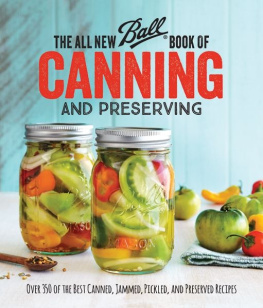
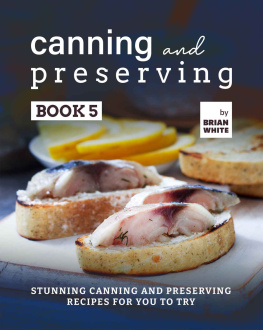
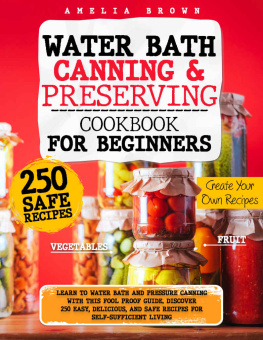
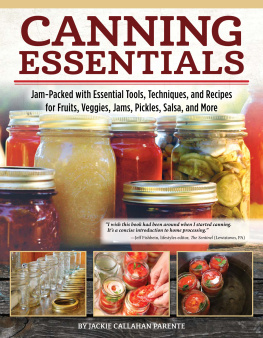
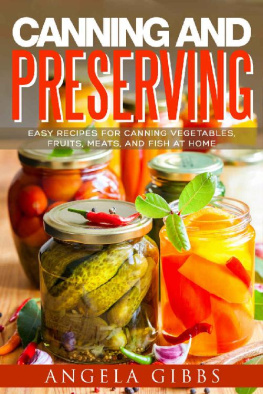
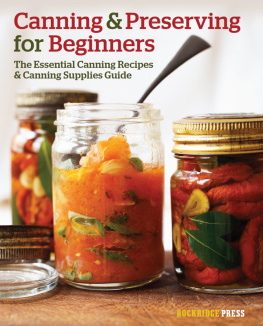


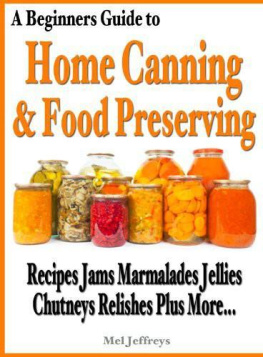
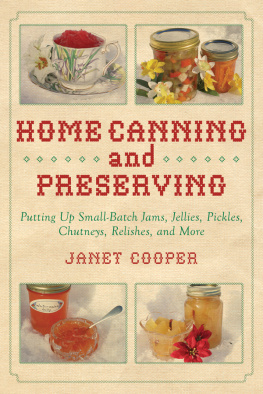
 BOOK OF CANNING AND PRESERVING
BOOK OF CANNING AND PRESERVING


